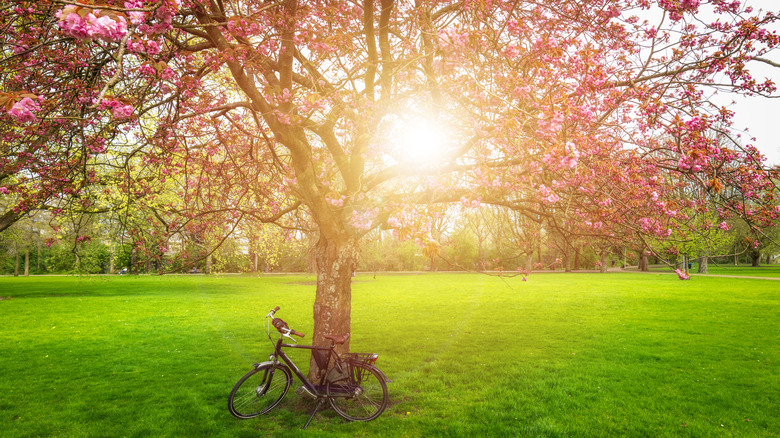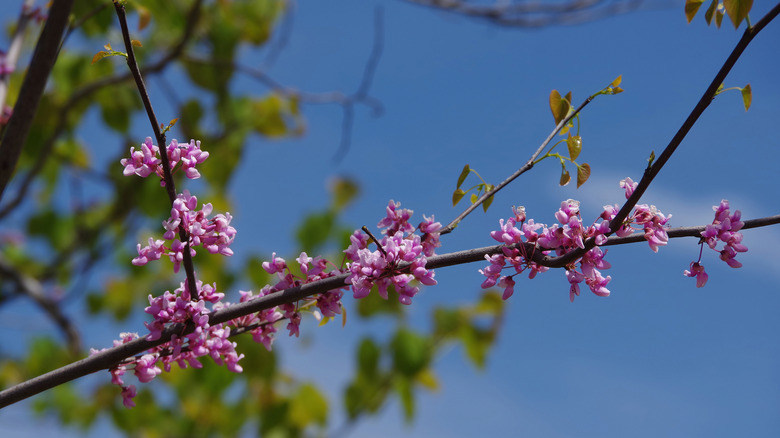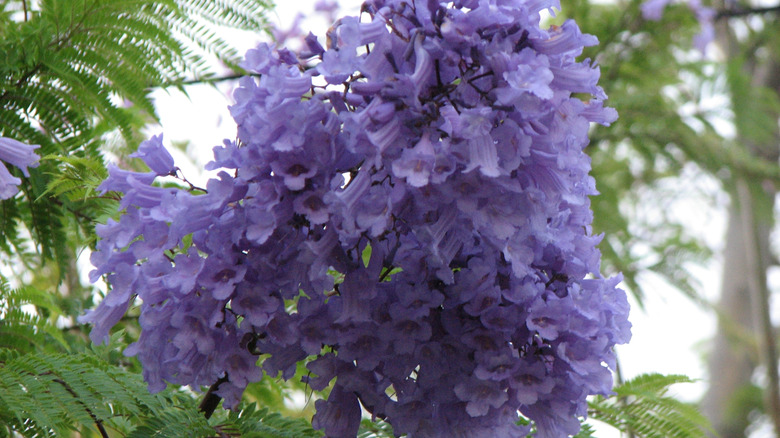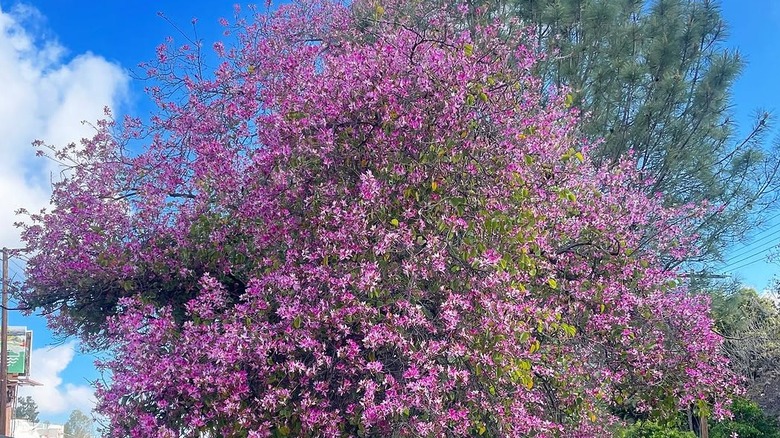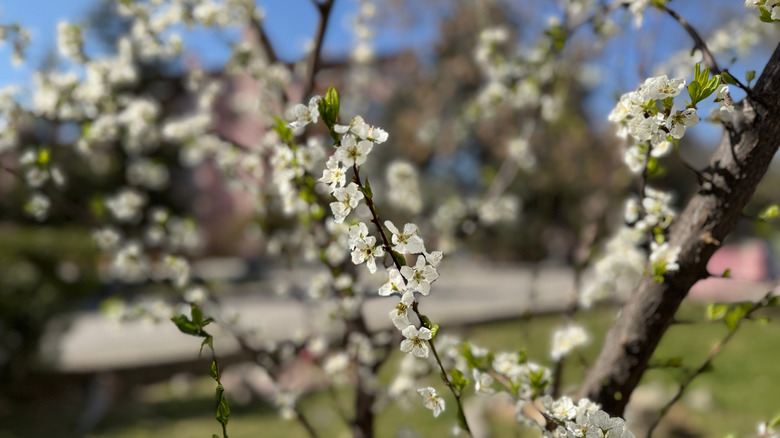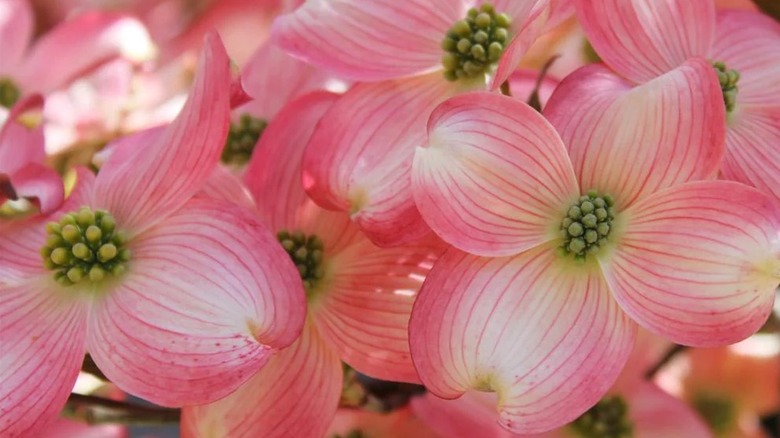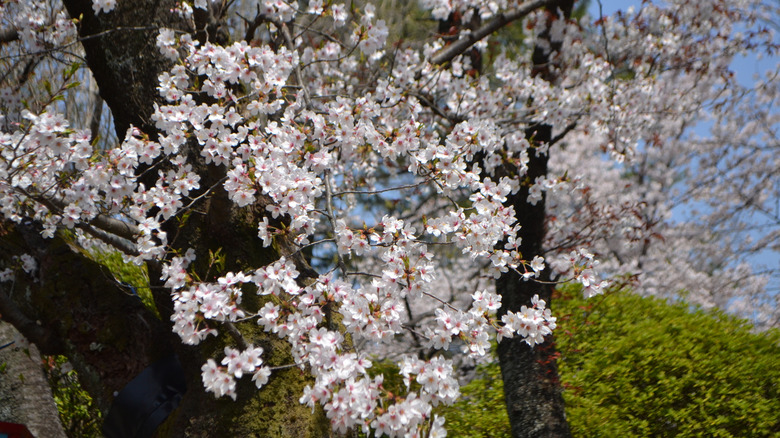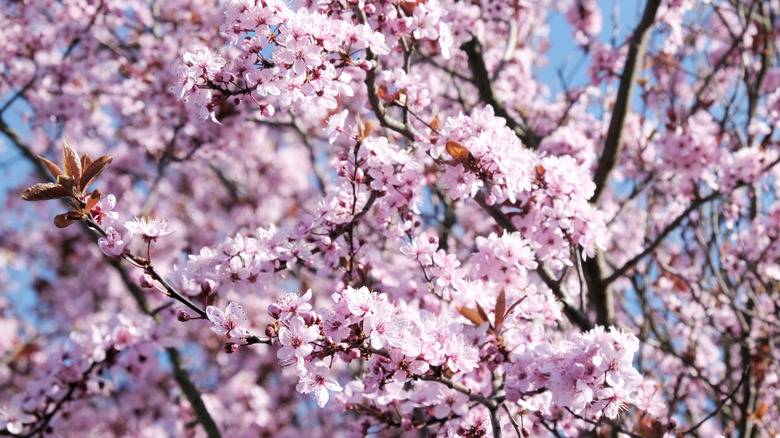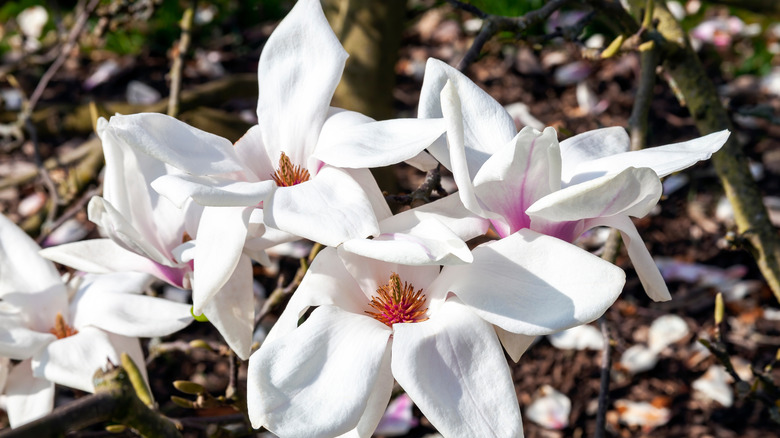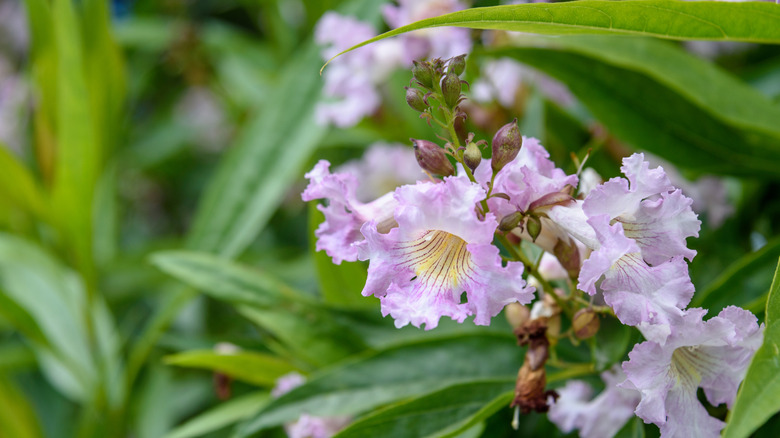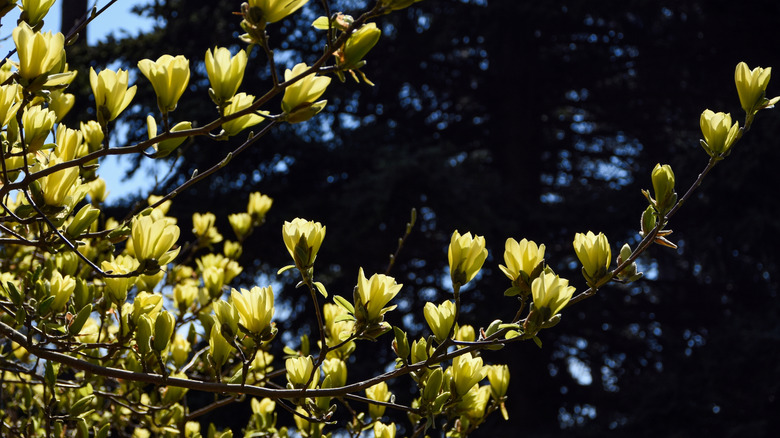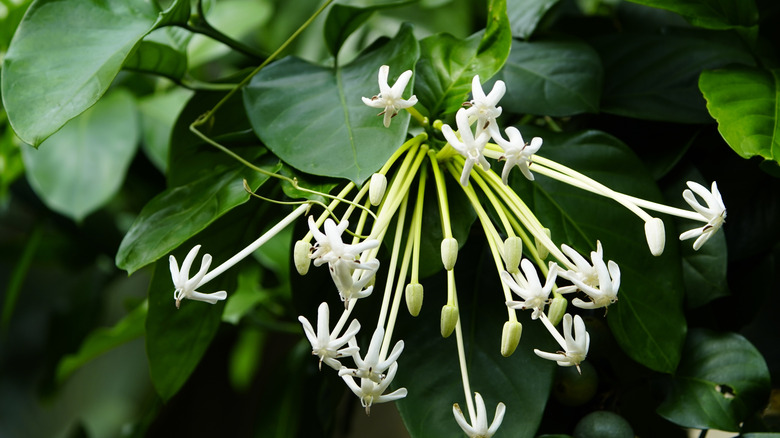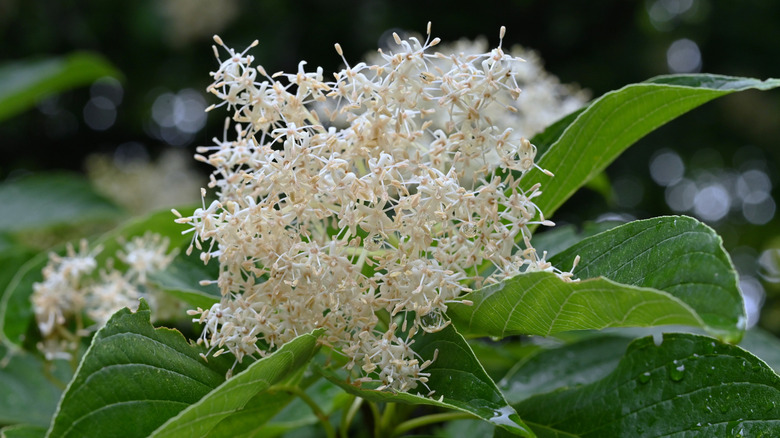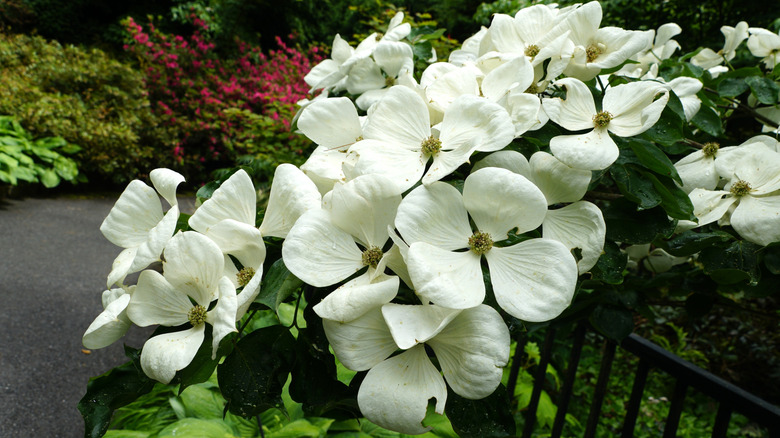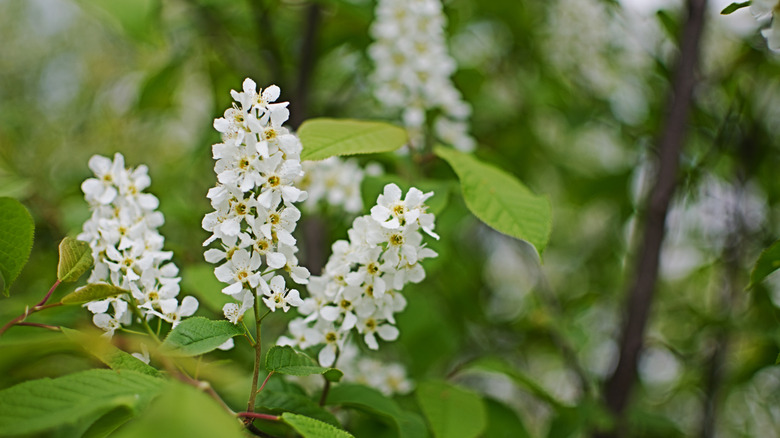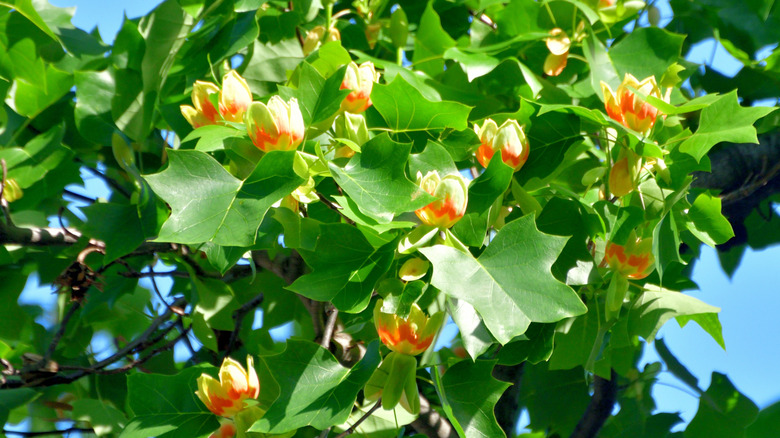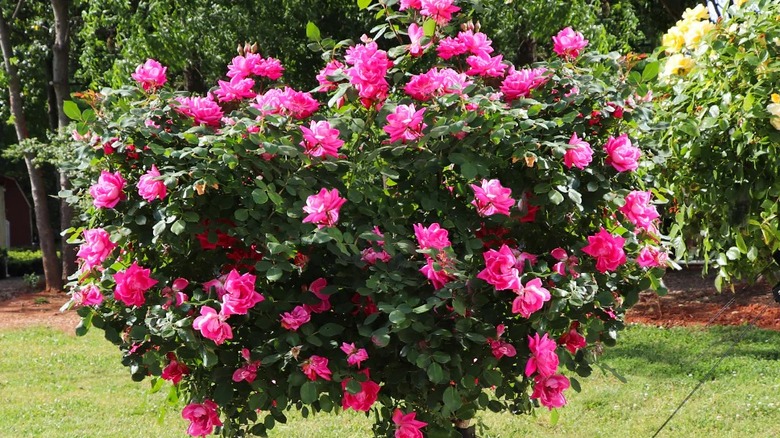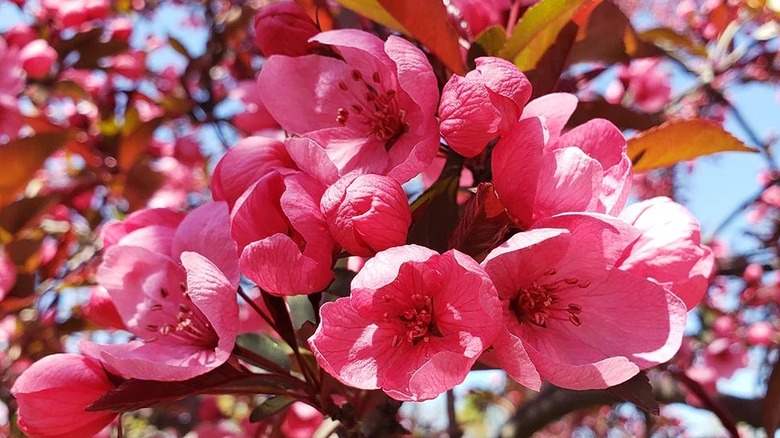Enjoy A Colorful Spring With 17 Varieties Of Fast-Growing Flowering Trees
While flowering shrubs and perennials certainly have their place in your garden, spring-blooming trees are equally valuable. Many pollinators depend on these early blooms for nectar, while birds stake them out as a nesting habitat or fruit. Certain butterflies and moths may also lay their eggs on their foliage if they believe their offspring will enjoy the taste of the emerging leaves. Plus, they provide shade during the hot summer while rendering a vertical structure to the yard. However, you may not be a big fan of the long wait for them to mature.
Fortunately, many spring-flowering trees exhibit fast growth rates, providing beautiful blooms and other benefits in a short time. Redbuds, jacarandas, plums, flowering dogwoods, cherries, magnolias, and roses are a few classic examples. Though, there are many more, as you'll discover below. What follows is a mix of U.S. native trees and well-behaved, non-invasive (to date) introduced species. Ensure they're hardy in your zone and match your site's cultural conditions before planting. Also, if you've got a small lot, stick to two or three varieties and supplement with shade trees for a more diverse habitat. With that said, let's discover fast-growing flowering trees that will beautify your spring landscape year after year.
Forest Pansy redbud
If you're looking for show-stopping pink trees to add to your yard that birds love to visit, look no further than 'Forest Pansy' redbud (Cercis canadensis 'Forest Pansy'). In early spring, this eastern U.S. native tree bursts into pea-shaped, rosy pink flowers that hummingbirds seek for nectar. This is followed by a breathtaking display of reddish-purple foliage, which, although it fades in summer heat, is back for autumn. Showy copper fruits persist through winter, attracting seed-eating birds. Group in borders as a deer-deterrent or frame along patios, away from winds, to future-proof against its weak-wooded nature.
Jacaranda
Planted in acidic soils and baking in full sun, you can expect your purple-flowering jacaranda trees to bloom in early spring. Botanically known as Jacaranda mimosifolia, these fast-growing trees offer a breathtaking sight, both in bloom and after they deflower, swathing the ground in their purple petals. Although Jacaranda's hardiness range is a bummer — it only survives outdoors in zone 9 and south — you can pop it in a container and overwinter inside. Keep Jacaranda trees protected from high winds outdoors, or their crowns may grow askew after suffering limb breakage. They can grow over 25 feet tall.
Hong Kong orchid tree
Orchid aficionados in zones 9 through 11 should look into the Hong Kong orchid trees (Bauhinia x blakeana) to make their spring even more ornate. Around November, their umbrella form becomes adorned with large, pink or purple flowers (much like orchids), with the display lasting continuously through April. They grow over 12 feet tall and twice as wide in full to partial sun. Use them as an accent or a specimen in foundation beds. Remember, you'll have to prune them regularly to maintain structural integrity and promote a more uniform shape of their crown.
American plum
American plum (Prunus americana) trees usher in the spring season with umbels of white flowers while they're yet to flush out new leaves. Red-purple plums follow the extremely fragrant flowers, attracting myriad songbirds and mammals. Fast growers in zones 4 through 9, American plums top out at 20 feet, albeit slightly wider. Their fruit pits, foliage, and stems are poisonous to all on consumption. Since they have thorns, you may plant them as a barrier plant to upgrade your home security. Or, provide them a spot in foundation beds, as they are fire-resistant. Avoid growing plum trees if your area is deer-strewn, and note that the fruit's pit are toxic and shouldn't be ingested.
Cherokee Brave flowering dogwood
Before leafing out, Cherokee Brave flowering dogwood (Cornus florida 'Comco No. 1') blankets itself in frothy clusters of rose-red blooms in spring, looking breathtakingly stunning. This holds true even when the pink centers eventually fade into white. Deer-resistant foliage grows maroon-hued in the fall while bird-attracting fruits persist through the year-end. Potentially the most drought-tolerant of all flowering dogwood trees, Cherokee Brave is worth consideration in zones 5 through 9. They perform best with moderate shade and can be sited alongside patios or walkways as specimens. They are relatively disease-resistant and can grow up to 20 feet tall.
Yoshino cherry
Known by several names, including Tokyo and Potomac cherry, Yoshino cherry (Prunus x yedoensis) is commonly planted in Washington. But it's snow-white or pink petals that unfurl as the spring unfolds deserve a spot elsewhere in hot and humid sites of zones 5 through 8. When not in bloom, this gorgeous flowering tree will attract birds to your yard with fruit and butterflies interested in birthing their babies. Although responsive to diverse soil conditions, they can get messy and require ample care, given their proclivity to diseases.
Rosebud cherry 'Autumnalis Rosea'
If you're keeping a Japanese garden, the rosebud cherry 'Autumnalis Rosea' (Prunus x subhirtella 'Autumnalis Rosea') trees may be of interest for their shade and wildlife value. As 'Autumnalis Rosea' survives longer than most decorative cherry trees, expect to enjoy massive clouds of pink petals in early spring and a second flush in the fall for years to come. Hummingbirds like their nectar, while others gorge on their summer fruits. Drought-tolerant, this hybrid cultivar blooms best in full sun exposure when planted in moist, fine-draining soils. It can grow over 20 feet tall and similarly wide and thrives in zones 6 through 8.
Wada's Memory magnolia
'Wada's Memory' magnolia (Magnolia x kewensis 'Wada's Memory') will surprise you with how quickly it grows and starts blooming. Young plants as short as 2 feet produce 7-inch-wide, pristine white blossoms, infusing the spring air with a tinge of orange and inviting butterflies. The deciduous tree also changes its shape from a parallel to a rounded form as it matures. Although low maintenance, you must position 'Wada's Memory' correctly. Moist, humusy, and well-draining soils are a must. Full sun is preferred, but light shade is tolerated in zones 5 through 8. These magnolia hybrids will make a beautiful focal point in foundation beds and around patios.
Pink Dawn chitalpa
Hybridized from catalpa and desert willow, 'Pink Dawn' chitalpa (Chitalpa tashkentensis 'Pink Dawn') brings their best attributes. It's tolerant of dry heat, which makes it suitable for water-wise landscapes in the Southwest. It features big, yellow-throated, lavender-pink flowers that remain in bloom from late spring into fall and are popular with hummingbirds and other birds. Although frost-hardy in zones 6 through 9, you might need to protect 'Pink Dawn' during establishment years when temperatures drop below 15 degrees Fahrenheit against winter damage. Considering they develop deep taproots (as opposed to surface roots), you can safely plant them along hardscapes without risking upending.
Yellow Bird magnolia
If you're weary of Mother Nature springing surprise frosts on your trees, consider planting 'Yellow Bird' magnolia (Magnolia acuminata 'Yellow Bird'). It can handle the surprise because it buds out in late spring. This single-trunked specimen will blaze yellow with 3-inch-wide, cup-shaped flowers for nearly three weeks, followed by copperish-yellow fall colors. Left unpruned, this deciduous tree can reach heights of 40 feet and widths of 25 feet, so space it accordingly in multi-season groves for deer resistance. You may also plant 'Yellow Bird' as a specimen in the front yard, provided it's amply sunny and grows in well-draining, moist soils. Best suited for zones 5 through 9.
Belize needle-flower tree
Although a rare find, the Belize needle-flower tree (Posoqueria latifolia) is a stunning tropical plant worth having in your yard if you live in zones 10 through 11. From spring through summer, its leafy stems are fringed by white blooms that unfurl like a firecracker's sparks, adding an exotic touch. Sweet, coffee bean-shaped edible fruits also make a show later, while nightscapes are infused with a heady jasmine scent. Belize is a vigorous grower, towering 10 feet high and wide by maturity. You must keep the soil moist while full-to-part sun is tolerated. Unless grouped for privacy, pop them in containers.
Giant dogwood
With its green leafy branches arranged in a layered form, giant dogwood (Cornus controversa) appears scenic wherever it's planted — though you may also enjoy growing it if you love to birdwatch. This is because several birds visit them to eat the bluish-black berries or to use their dense canopies as nesting sites, especially near woodlands. Fortunately, deer usually avoid them. Masses of creamy-white flowers offer an arresting display in May and June. In zones 5 through 8, giant dogwoods can grow over 35 feet tall and wide. Although they can withstand twig blight, they may still be susceptible to typical dogwood diseases, including anthracnose, when stressed.
Venus dogwood
Crossbred by Rutgers University, Venus dogwoods (Cornus x 'KN30-8') support some of the largest floral bracts of all dogwoods, literally appearing smothered by white flowers in spring. Later, they produce strawberry-like fruits, while their green leaves turn a reddish-bronze for fall. Venus dogwoods are cold-hardy in zones 5 through 9 and exhibit resistance to anthracnose and powdery mildew. They're also drought-tolerant after establishment. Topping out at about 20 feet, they're one of the best trees to plant for privacy if you have a smaller backyard. While they enjoy full sun, it's best to provide them protection during afternoons and mulch their roots in hot climates.
Black cherry
As North America's biggest cherry tree, black cherry (Prunus serotina) is popular for providing ecosystem services that rival the mighty oaks. Many birds and mammals harbor in their canopies and subsist on their fruits, while butterflies breed on their leaves. However, you can grow black cherry trees for spring interest, given their white or pink, sweetly fragrant blooms dangling from leafy branches from April through May. If you don't want these deer-resistant trees growing too tall, cut back their foliage every couple of years to the desired height. It thrives in zones 2 through 8, but the plant parts are toxic to humans and pets if ingested.
Tulip poplar
As tulip poplars (Liriodendron tulipifera) grow very tall and become messy when they defoliate. While they flourish in zones 4 through 9, they might not be suitable for small yards. But if you have the space, planting this gorgeous tree will have hummingbirds flock to your yard, apart from nesting birds. After the U.S. native buds in winter — a spectacle in itself, given the buds' resemblance to a duck's bill — you'll have a mass of orange-tinged, yellowish-green flowers by late spring. Some birds like to eat them whole. Note that their flowers will not be as visible once the trees reach mature heights, as they typically overlay the highest canopy.
Knockout rose trees
Introduced in 2000 as beginner-friendly, fast-growing roses in a range of colors for gardeners strapped for time, Knockout roses (Rosa 'Radcon' Tree) come in a trained tree form. However, they are quite short, measuring about 4 feet. Cultural requirements are fairly similar to their shrubby forms. Give them full sun exposure and loamy, fine-draining soil in zones 5 through 10. This will encourage the rose trees to bloom with aplomb from spring through frost without necessitating deadheading or fertilization. Although removing faded blooms will enhance their appearance. You can keep them potted if you like and use them to grace your patios or pathways.
Show Time crabapple
Proven Winner's Show Time crabapples (Malus 'Shotizam') will stop you right in your hurried tracks with their profuse show of fuchsia red flowers that conceal the leafless branches in the spring. Even bees and butterflies adore their flowers. They render multi-season interest with their rust-tinged green foliage, which turns a fiery orange in fall while cradling bright red fruits. Cold hardy in zones 4 through 8, Show Time crabapples must be planted in full sun. To maintain a single-stem form, you'll need to prune the flowering variety in winter. Pot them or accent your garden with their 25-foot frame.
